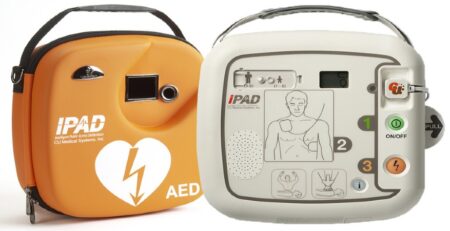Optimal Defibrillator Maintenance: Best Practices to Follow
When you are responsible for a defibrillator, it is crucial to pay special attention to two essential components: the electrodes and the battery. The lifespan of these components varies from defibrillator model to model. Separate production and expiration dates for electrodes and the battery are usually indicated on your defibrillator. However, it’s important not to confuse these two dates. The production date will be accompanied by a factory icon, while the expiration date will feature an hourglass icon. Additionally, be aware of whether you have a service agreement for your defibrillator and your responsibilities under it, such as battery and electrode replacement dates.
Electrode Maintenance for Your Defibrillator:
The general durability of a set of electrodes ranges from approximately 2 to 5 years. We always encourage our customers to find the specific durability of each set on the packaging. The lifespan of electrodes varies across different models. Some electrodes can last up to 3 years, like those in models IPAD SP1 and IPAD NF1200, while electrodes in other models can last up to 5 years, as seen in our Mindray defibrillators. Thus, it’s crucial to keep track of the various expiration dates for your specific defibrillator.
Furthermore, our IPAD SP1 model features a display that allows you to monitor the status of all components.
If the durability of electrodes is exceeded, it’s important to replace them even if the defibrillator hasn’t been used. Electrodes contain a gel that can dry out over time, potentially affecting their ability to adhere properly to a patient’s chest during a defibrillation.
You should replace electrodes on your defibrillator if:
- The defibrillator has been used.
- The packaging of the electrodes is damaged.
- The expiration date of the electrodes has passed.
Battery Maintenance for Your Defibrillator:
The battery is also an indispensable part of your defibrillator, and proper maintenance is essential. The timing for battery replacement varies among different defibrillator models. Battery lifespans can range from 2 to 7 years. For example, batteries in IPAD SP1, IPAD NF1200, and Philips defibrillators can last up to 4 years, while Mindray’s batteries can last up to 5 years. Always remember to note the battery’s expiration date when purchasing your defibrillator.
You should replace the battery on your defibrillator if:
- The defibrillator is blinking.
- The defibrillator is emitting an alarm sound.
Defibrillators with WiFi or 4G Connectivity:
At Cardiocare, you can purchase defibrillators with WiFi and 4G connectivity. The advantage of having a defibrillator connected to WiFi or 4G is the ability to monitor it around the clock. Normally, defibrillators aren’t regularly maintained unless there’s a service agreement in place, which could lead to functionality issues. WiFi or 4G connectivity ensures ultimate maintenance. The defibrillator detects errors and alerts you immediately, allowing you to address the issue promptly. There’s also a defibrillator cabinet with built-in 4G monitoring available now. The Rotaid 24/7 cabinet sends notifications via SMS and email as soon as a defibrillator reports an error or becomes unusable. Additionally, you receive reminders when the cabinet is opened or closed, and if the defibrillator is removed from its place, providing insights into potential usage.
General Maintenance Tips for Your Defibrillator:
- Always note the expiration dates for both electrodes and the battery to avoid exceeding them. You can even mark them in your calendar.
- Check if the packaging of electrodes is damaged. Replace them if it is.
- Replace used components if your defibrillator has been used.
- Conduct regular checks on your defibrillator.
- Ensure the defibrillator is in its place and properly attached.
- Respond to alarms from your defibrillator. Some defibrillators perform automatic self-tests, so pay attention to alarms indicated by sound or blinking lights.
Advantages of a Service Agreement:
At Cardiocare, you can opt for a service agreement for your defibrillator. With a service agreement, we assist you in maintaining your defibrillator. For instance, our basic package ensures you receive new electrodes and batteries when they expire or are used. You’re responsible for replacing the components. If the defibrillator is taken to a hospital by emergency responders, we provide a loaner defibrillator.
With an On-Site service agreement, we come to you to replace components when it’s time, alleviating the responsibility of tracking expiration dates and replacements. A service agreement guarantees that your defibrillator is always ready to perform life-saving treatments.
Want to Ensure Secure Maintenance?
At Cardiocare, you can sign up for a service agreement for your defibrillator, ensuring proper maintenance and relieving you of the need to remember expiration dates. If you have questions about the service agreement or maintaining your defibrillator, feel free to call us at +45 86 28 49 00 or send an email to info@cardiocare.dk.


